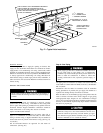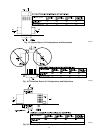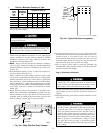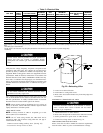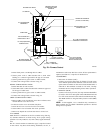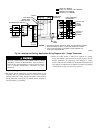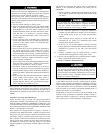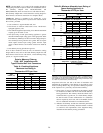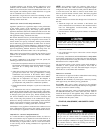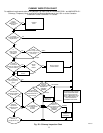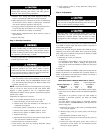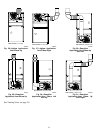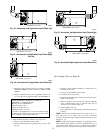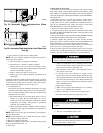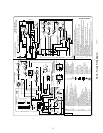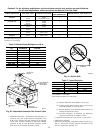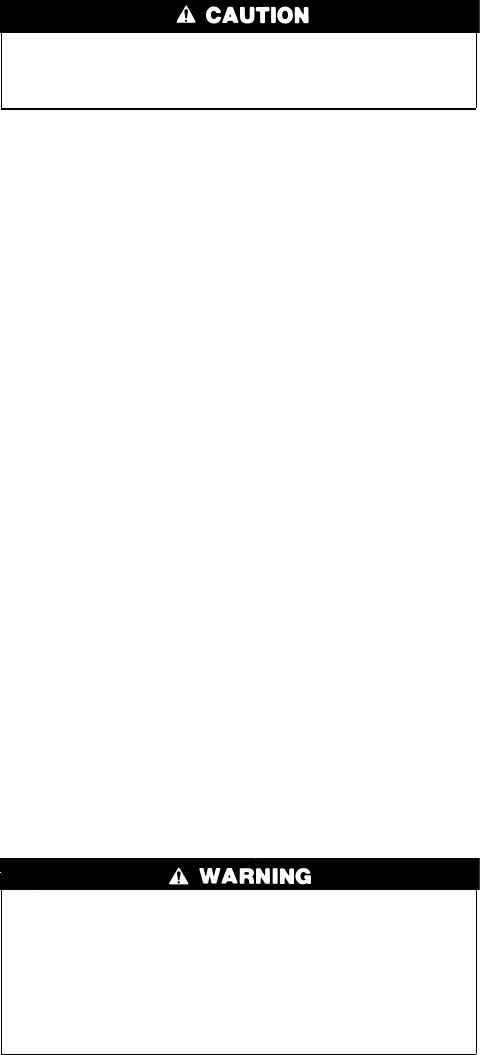
A chimney without a clay tile liner, which is otherwise in good
condition, shall be rebuilt to conform to ANSI/NFPA 211 or be
lined with a UL listed (ULC listed in Canada) metal liner or UL
listed Type-B vent. Relining with a listed metal liner or Type-B
vent is considered to be a vent-in-a-chase.
If a metal liner or Type-B vent is used to line a chimney, no other
appliance shall be vented into the annular space between the
chimney and the metal liner.
APPLIANCE APPLICATION REQUIREMENTS
Appliance operation has a significant impact on the performance
of the venting system. If the appliances are sized, installed,
adjusted, and operated properly, the venting system and/or the
appliances should not suffer from condensation and corrosion. The
venting system and all appliances shall be installed in accordance
with applicable listings, standards, and codes.
The furnace should be sized to provide 100 percent of the design
heating load requirement plus any margin that occurs because of
furnace model size capacity increments. Heating load estimates
can be made using approved methods available from Air Condi-
tioning Contractors of America (Manual J); American Society of
Heating, Refrigerating, and Air-Conditioning Engineers; or other
approved engineering methods. Excessive oversizing of the fur-
nace could cause the furnace and/or vent to fail prematurely.
When a metal vent or metal liner is used, the vent must be in good
condition and be installed in accordance with the vent manufac-
turer’s instructions.
To prevent condensation in the furnace and vent system, the
following precautions must be observed:
1. The return-air temperature must be at least 60°F db except for
brief periods of time during warm-up from setback at no lower
than 55°F db or during initial start-up from a standby
condition.
2. Adjust the gas input rate per the installation instructions. Low
gas input rate causes low vent gas temperatures, causing
condensation and corrosion in the furnace and/or venting
system. Derating is permitted only for altitudes above 2000 ft.
3. Adjust the air temperature rise range to the midpoint or
slightly above. Low air temperature rise can cause low vent
gas temperature and potential for condensation problems.
4. Set the thermostat heat anticipator or cycle rate to reduce short
cycling.
Air for combustion must not be contaminated by halogen com-
pounds which include chlorides, fluorides, bromides, and iodides.
These compounds are found in many common home products such
as detergent, paint, glue, aerosol spray, bleach, cleaning solvent,
salt, and air freshener, and can cause corrosion of furnaces and
vents. Avoid using such products in the combustion-air supply.
Furnace use during construction of the building could cause the
furnace to be exposed to halogen compounds, causing premature
failure of the furnace or venting system due to corrosion.
Vent dampers on any appliance connected to the common vent can
cause condensation and corrosion in the venting system. Do not
use vent dampers on appliances common vented with this furnace.
ADDITIONAL VENTING REQUIREMENTS
A4″ round vent elbow is supplied with the furnace. A 5 inch or 6
inch vent connector may be required for some model furnaces. A
field-supplied 4 inch to 5 inch or 4 inch to 6 inch sheet metal
increaser fitting is required when 5 inch or 6 inch vent connector
is used. See Fig. 26–38 Venting Orientation for approved vent
configurations.
NOTE: Vent connector length for connector sizing starts at
furnace vent elbow. The 4 inch vent elbow is shipped for upflow
configuration and may be rotated for other positions. Remove the
3 screws that secure vent elbow to furnace, rotate furnace vent
elbow to position desired, re-install screws. The factory-supplied
vent elbow does NOT count as part of the number of vent
connector elbows.
The vent connector can exit the door through one of 5 locations on
the door.
1. Attach the single wall vent connector to the furnace vent
elbow, and fasten the vent connector to the vent elbow with at
least two field-supplied, corrosion-resistant, sheet metal
screws located 180° apart.
2. Vent the furnace with the appropriate connector as shown in
Fig. 26–38.
Personal injury can result form sharp metal edges, etc. Be
careful when removing parts. Gloves and safety glasses
should be worn when servicing equipment.
3. Orient the door to determine the correct location of the door
cutout to be removed.
4. Use aviation-type tin snips to remove the correct U-shaped
cut-out on door.
An accessory Vent Guard Kit, KGAVG0101DFG is REQUIRED
for downflow applications for use where the vent exits through the
lower portion of the furnace casing door. Refer to the Vent Guard
Kit Instructions for complete details.
The horizontal portion of the venting system shall maintain a
minimum of 1/4-in. upward slope per linear ft and it shall be
rigidly supported every 5 ft or less with metal hangers or straps to
ensure there is no movement after installation.
SIDEWALL VENTING
This furnace is not approved for direct sidewall horizontal venting
without the use of an add-on power venter.
In the U.S.: Per the NFGC, any listed power venter may be used,
when approved by the authority having jurisdiction.
In Canada: Only power venters approved by the appliance
manufacturer and where allowed by the authority having jurisdic-
tion may be used for sidewall venting.
The only approved power venter is the Field Controls SWG-4D
and SWG-5D sidewall power venter. Select the power venter to
match the btuh input of the appliance being vented. Follow all
manufacturer’s installation requirements for venting and termina-
tion included with the power venter.
START-UP, ADJUSTMENT, AND SAFETY CHECK
Step 1—General
This furnace is equipped with manual reset limit switches in
the gas control area. The switches open and shut off power to
the gas valve if a flame rollout or overheating condition
occurs in the gas control area. DO NOT bypass the switches.
Correct inadequate combustion air supply problem and reset
the switches. Failure to follow this warning can cause fire,
explosion, personal injury, or death.
21



